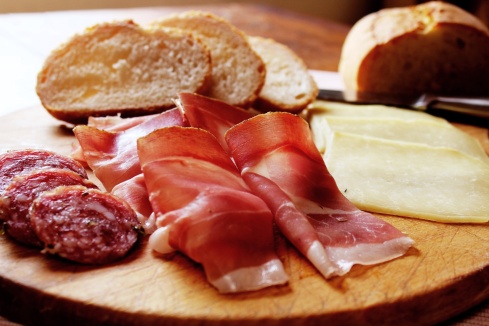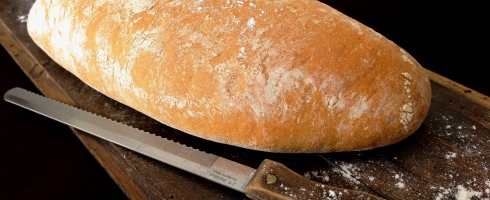“L’uomo non vive di solo pane / Man does not live by bread alone” … but this certainly doesn’t seem to apply in Tuscany. For centuries Tuscan bread has been a staple for the poor. The Tuscan bread recipe is salt-free, therefore called in Italian “pane sciapo”. In fact, its taste goes well with traditional Tuscan cuisine rich in salt and abundant flavors. It has a crispy reddish crust, while the interior is soft, but not spongy . It is a perfect base for delicious appetizers or “stuzzichini”. It can be served with tasty cured meat products, “affettato”, such as Tuscan Prosciutto Crudo, salami (fennel-flavored finocchiona) or Tuscan pecorino cheese, and it is one of the most appetizing ways to start a meal. It can also accompany savory soups such as “ribollita” and “pappa al pomodoro”. It can also be used for the typical “panzanella”, a bread and tomato salad. Moreover it is very palatable in the form of crouton slices, thin pieces of grilled or fried bread. The croutons are very good with chicken liver pate’, olive paste, or as the base of the famous “bruschetta” with olive oil, garlic, tomatoes and fresh basil. The lack of salt has historical roots: around the twelfth century, because of the struggle between the cities of Pisa and Florence, the maritime republic stopped the salt trade to the countryside, and because of this the farmers had to prepare their bread without salt. Today, this tradition is generally maintained, although nowadays in some areas of Tuscany bread is lightly salted. You can add a small amount of salt (about 5 g (1 tsp) for 500 g of flour, 3 cups), according to your taste and to match the food you are eating.
TUSCAN BREAD
Preparation time: 3 hours Cooking time: 35-40 minutes Servings: 8

INGREDIENTS
500 g (3 cups) gluten-rich flour (Manitoba)
260 ml (1 cup + 2 tablespoons) water at 45 °C -110 °F
5 g (1 tsp) sugar
1 package (7 g, 1 heaping teaspoon) dried yeast or 1 cube (25 g, about 1 ounce) fresh yeast
2 tablespoons olive oil (Extra Virgin)
DIRECTIONS
1. In a small glass or bowl, dissolve in about 100 ml of the warm water, sugar and yeast. Sugar is the so-called ” food” for the yeast
2. In another bowl, mix the remaining water well with the oil
3. Pour the liquid containing sugar and yeast into a large glass bowl. Add half of the flour and mix well until smooth
4 . Continue adding the remaining flour and the water with olive oil until a smooth ball can be formed
5. Remove the dough from the bowl and knead on a lightly floured surface, by hand for about 10 minutes. Do not add too much flour otherwise the dough will become tough
6. Put the dough in a glass bowl and let rise for about 20 min. Cover with a cotton towel. Let rise in a warm draft-free place at a temperature of approximately 30°C or 85°F.
7. After this time, knead the dough on a floured work surface about a dozen times.
8. Form a strand without handling it too much, cover with a sprinkling of flour , place on a baking sheet previously covered with greaseproof baking paper . Let rise for about 2 hours covered with a cotton towel. Remember that the dough should rise in a warm room.
9. Preheat oven to 180 °C.
10. Bake for 35-40 minutes until golden brown.
11. Remove from oven and let cool on a rack. – Paola







